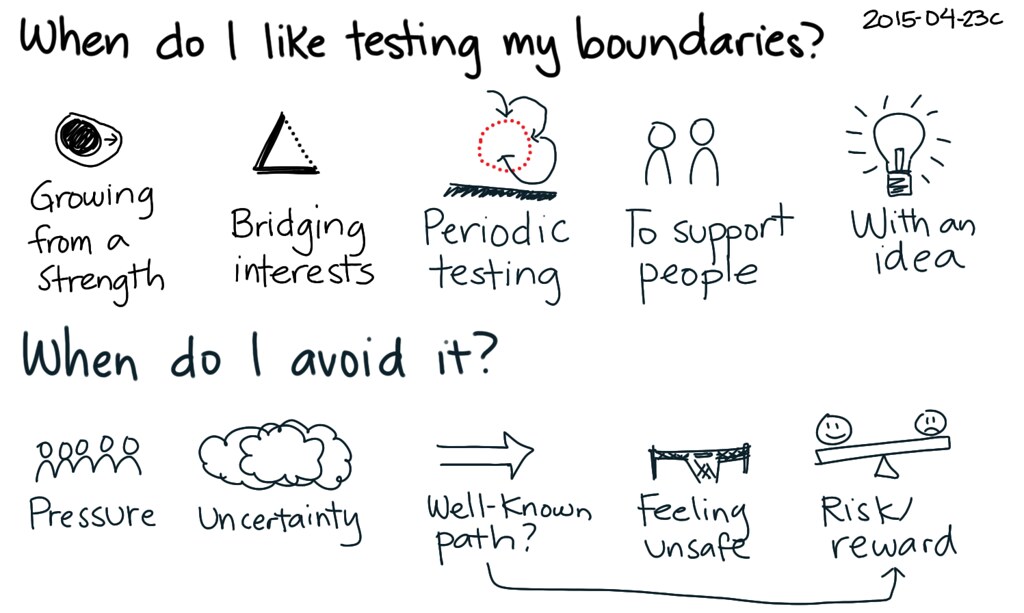When I was growing up, I never learned what we now refer to as “appropriate” boundaries. In my world, boundaries were hierarchical. If you were older you had priority. If you were male you had priority. The more priority you had the more free reign you had; as in you were allowed to cross any possible boundary you please. If you were at the bottom, your boundaries were allowed to be crossed and you were forbidden to cross anyone else’s.
It was a lonely existence, as I recall. I remember continually thinking, I wish I could find someone that felt safe so I could show them how much damage this experience causes. After I became an elder, I began to think, “I wonder how many other people experience this besides me; and have they ever spoken up?” My dad used to tell me, “The truth will set you free.” Apply this to what I was seeing in this boundary issue. Lately, all I can think is, “What words do I have to use to make people see how much harm is happening.”
First, I had to learn the word “Boundaries” and what that meant to everyone. At the bottom of society, boundaries look way different than they do when you have any sort of privilege. As I went through this journey from living in a world where the social structure was telling me I was nobody – to a place where I will cross a threshold that states I had met the requirements to become a Licensed Clinical Psychologist (i.e. I cross nobody’s boundaries without complete informed consent that specifies the limits of our boundaries; And nobody crosses mine without my consent).
As I studied for over a decade to understand the boundaries of a psychologist, I began to realize what psychologists were attempting to create. The boundaries a licensed clinical psychologist creates with their clients are boundaries that I call “permeable”. I began to see these boundaries like bubbles that never pop. One could move through if, once they reach the bubble, they look at themselves in the reflection (like a magic mirror gate). Once they are able to see themselves clearly, they can enter into that membrane and be closer (always within safe limits). They will not cause intentional harm within this bubble, as they are responsible, sovereign beings once they are able to cross that membrane.
Another metaphor that keeps popping into my head is the idea of boundaries being like an atmosphere. Anything that enters a sovereign being’s atmosphere – must go through a boundary that will burn off anything that isn’t true. The only part that reaches the ground is authentic, responsible, sovereign beings. They continually work towards recognizing that Their emotions, thoughts, and behaviors change the Environment as much as the Environment’s emotions, thoughts and behaviors change them. One that recognizes that sometimes, in the beginning, it’s awkward; and that’s okay too.
There is also more than just one bubble…there are layers of bubbles. They are determined by the role we play and the value we hold within it. For example, I hold the role of wife to my husband with the value that we are both monogamous. He is allowed to cross many of my boundaries that nobody else is.
On the other hand, when I hold the role as a psychologist, I recognize that my boundaries look very different. The value I hold in that role is healing. I contain a challenge for others over a safety net. I then attempt to create a dynamic of the least amount of harm with the most amount of growth. That means that the boundary I hold for them is one of authenticity and transparency, yet not part of my inner circle (which for me is my husband, followed by my offspring). I do my best to not burden a client with my struggles; and own when I do accidentally. The client and I grow simultaneously – making it symbiotic and synergistic.
If for some reason, we are unable to create a symbiotic and synergistic connection (as client and therapist) – we must create a very clear disconnect. To not create that clear boundary would cause harm to all involved. Sometimes the client isn’t ready; and sometimes the therapist isn’t ready – either way, the one truth that trumps all other truths for a Psychologist is, “Do no harm, reduce harm that’s done, recognize their influence, and do their own mental health healing.” Here is the jargon version from the American Psychological Association (APA) – i.e. the governing body of licensed clinical psychologists:
Principle A: Beneficence and Nonmaleficence
Psychologists strive to benefit those with whom they work and take care to do no harm. In their professional actions, psychologists seek to safeguard the welfare and rights of those with whom they interact professionally and other affected persons, and the welfare of animal subjects of research. When conflicts occur among psychologists’ obligations or concerns, they attempt to resolve these conflicts in a responsible fashion that avoids or minimizes harm. Because psychologists’ scientific and professional judgments and actions may affect the lives of others, they are alert to and guard against personal, financial, social, organizational, or political factors that might lead to misuse of their influence. Psychologists strive to be aware of the possible effect of their own physical and mental health on their ability to help those with whom they work.
Not all psychologists are perfect, and sometimes boundaries are clearly crossed. If significant harm occurs to any of the parties involved (including the psychologist), they lose their license and forfeit the title “Psychologist”.
In other words, Psychologists do their best to create clear boundaries. Both, psychologists and boundaries, are not always “perfect” or “clear”. They continually grow organically – seeking the least amount of harm with the most amount of growth.

Doctor of Clinical Psychology, PsyD., middle aged, mother of two young adults, Latina, neurodivergent, came from the dirt and clawed my way out through the US education system, digital and AI artist, web programmer, writer, pure water elemental, dark creature, and goddess of water (one of many)!
I am one, of infinite possibilities.
This is me, who are you?





Leave a Reply